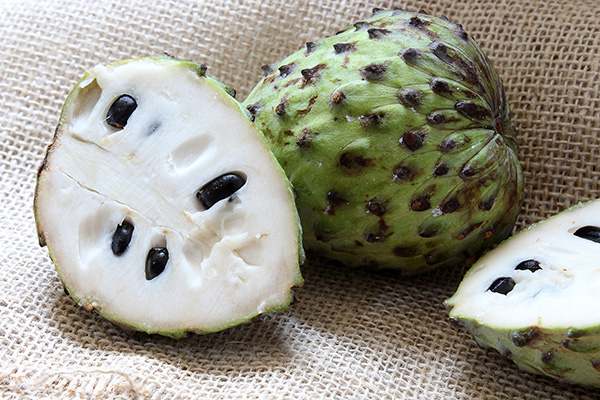What Does Soursop Taste Like? An In-Depth Exploration
Soursop, scientifically known as Annona muricata, is a tropical fruit celebrated for its unique flavor and creamy texture. This article delves into the taste profile of soursop, its culinary uses, nutritional benefits, and cultural significance, while also providing a comprehensive FAQ section and a table summarizing key information.
Introduction to Soursop
Soursop is a large, heart-shaped fruit with a spiky green exterior. It is native to the tropical regions of the Americas and is widely cultivated in Southeast Asia, the Caribbean, and parts of Africa. The fruit is known by various names, including guanabana in Spanish-speaking countries and graviola in some regions. Despite its intimidating appearance, the flesh of the soursop is soft, creamy, and packed with flavor.
Flavor Profile of Soursop
The taste of soursop is often described as a delightful blend of several tropical fruits. The flavor profile includes:
- Sweetness: Ripe soursop has a natural sweetness that is reminiscent of bananas and mangoes.
- Tanginess: The fruit also has a tangy, slightly sour note that adds complexity to its flavor, making it refreshing.
- Creaminess: The texture of soursop is creamy, akin to that of custard or ripe avocado, which enhances its appeal in smoothies and desserts.
- Aromatic Qualities: Soursop has a fragrant aroma, often compared to strawberries and pineapples, which further elevates the sensory experience of consuming it.
In summary, the flavor of ripe soursop can be described as a harmonious combination of banana, pineapple, coconut, and mango, with hints of strawberry. This unique blend makes it a versatile ingredient in various culinary applications.
Culinary Uses of Soursop
Soursop is enjoyed in many forms across different cultures. Here are some popular ways to incorporate soursop into your diet:
- Fresh Consumption: The simplest way to enjoy soursop is to cut it open and scoop out the flesh with a spoon. The creamy texture makes it a delicious snack on its own.
- Smoothies and Juices: Soursop is commonly blended into smoothies and juices. Its creamy consistency and sweet-tangy flavor make it a perfect addition to tropical beverages.
- Ice Cream and Sorbet: Soursop is a popular flavor for ice creams and sorbets, especially in Latin America and the Caribbean. The fruit’s natural sweetness allows for a refreshing frozen treat.
- Beverages: In countries like the Dominican Republic, soursop is used to make a refreshing drink called “champola de guanábana,” which combines the fruit with sugar and water.
- Culinary Dishes: In some cultures, unripe soursop is cooked and used in savory dishes, such as soups and salads. For example, in Indonesia, it is often added to salads, while in Brazil, it can be fried or boiled.
- Desserts: Soursop can also be used in desserts like jellies, jams, and cakes, where its unique flavor can shine.
Nutritional Benefits of Soursop
Soursop is not only delicious but also packed with nutrients. Here are some key nutritional benefits:
- Low in Calories: Soursop is low in calories, making it a healthy snack option. A 100-gram serving contains approximately 66 calories.
- Rich in Vitamins: The fruit is an excellent source of vitamin C, providing about 34% of the recommended daily intake in a single serving. It also contains small amounts of other vitamins and minerals, including potassium and magnesium.
- High in Fiber: Soursop is a good source of dietary fiber, which aids in digestion and promotes gut health.
- Antioxidant Properties: Soursop contains antioxidants that help combat oxidative stress and may have potential health benefits, including anti-inflammatory properties.
Cultural Significance of Soursop
Soursop holds cultural importance in many regions where it is grown. In tropical countries, it is often associated with traditional medicine and is used in various herbal remedies. The leaves, fruit, and stems of the soursop plant are utilized for their potential health benefits.In addition to its medicinal uses, soursop is celebrated for its role in local cuisines. It is a staple ingredient in many desserts, drinks, and savory dishes, reflecting the culinary diversity of the regions where it is cultivated.
FAQ Section
1. What does soursop taste like?
Soursop has a sweet and tangy flavor, often described as a blend of banana, pineapple, coconut, and mango, with hints of strawberry.
2. How do you eat soursop?
Soursop can be eaten fresh by cutting it open and scooping out the flesh. It is also commonly used in smoothies, juices, ice creams, and desserts.
3. Is soursop healthy?
Yes, soursop is low in calories, rich in vitamin C, high in fiber, and contains antioxidants, making it a nutritious addition to your diet.
4. Can you eat unripe soursop?
Yes, unripe soursop can be consumed, but it has a different flavor profile and is often used in savory dishes rather than eaten raw.
5. Where can I buy soursop?
Soursop can be found in tropical regions, local markets, and specialty grocery stores. It is also available in frozen or canned forms in some areas.
Information Table
| Attribute | Details |
|---|---|
| Scientific Name | Annona muricata |
| Common Names | Soursop, Guanabana, Graviola |
| Flavor Profile | Sweet, tangy, creamy |
| Nutritional Benefits | High in vitamin C, fiber, low calories |
| Culinary Uses | Fresh, smoothies, ice cream, desserts |
| Cultural Significance | Used in traditional medicine and local cuisines |
For more detailed information about soursop, you can refer to its Wikipedia page: Soursop – Wikipedia.
Conclusion
Soursop is a tropical fruit that offers a unique and delightful flavor experience. Its sweet and tangy taste, creamy texture, and versatility in culinary applications make it a beloved fruit in many cultures. Whether enjoyed fresh, blended into a smoothie, or incorporated into desserts, soursop is a delicious addition to any diet. With its nutritional benefits and cultural significance, soursop is truly a gift from nature worth exploring.



